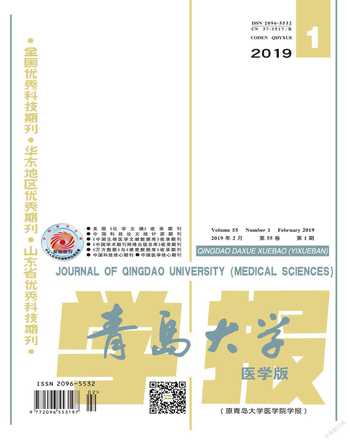铁蛋白对MPP+诱导MES23.5细胞损伤的作用
张娜 谢俊霞 徐华敏
[摘要] 目的 探讨外源性铁蛋白(Ferritin)对1-甲基-4-苯基吡啶阳离子(MPP+)诱导的MES23.5細胞损伤的作用。
方法用四甲基偶氮唑盐(MTT)比色法筛选MPP+最适造模浓度;分别应用MPP+、Ferritin、Ferritin+MPP+处理MES23.5多巴胺能神经细胞,然后应用CCK8试剂盒检测细胞存活率,流式细胞术检测细胞线粒体跨膜电位(△Ψm)。
结果MPP+处理MES23.5细胞后,细胞存活率和△Ψm均下降,与对照组相比差异具有统计学意义(F=143.044、70.924,P<0.01)。Ferritin预处理4 h可明显抑制MPP+导致的细胞存活率和△Ψm的下降(F=51.905、35.218,P<0.01)。
结论Ferritin对MPP+诱导的MES23.5细胞损伤具有保护作用,能够拮抗MPP+诱导的细胞存活率和△Ψm的下降。
[关键词] 铁蛋白质类;帕金森病;1-甲基-4-苯基吡啶;神经保护
[中图分类号] R338;R977.6
[文献标志码] A
[文章编号] 2096-5532(2019)01-0028-04
EFFECT OF FERRITIN ON MES23.5 CELL DAMAGE INDUCED BY 1-METHYL-4-PHENYLPYRIDINIUM
ZHANG Na, XIE Junxia, XU Huamin
(Department of Physiology and Pathophysiology, Medical College of Qingdao University, Qingdao 266071, China)
[ABSTRACT]ObjectiveTo investigate the effect of exogenous ferritin on MES23.5 cell damage induced by 1-methyl-4-phenylpyridinium (MPP+).
MethodsMethyl thiazolyl tetrazolium colorimetry was used to screen out the optimal concentration of MPP+ for modeling. MES23.5 dopaminergic neural cells were treated with MPP+, ferritin, or ferritin+MPP+. CCK8 assay was used to measure cell viability, and flow cytometry was used to measure mitochondrial transmembrane potential (ΔΨm).
Results
Compared with the control group, the MPP+ treatment group had significant reductions in cell viability and ΔΨm of MES23.5 cells (F=143.044 and 70.924,P<0.01). Ferritin pretreatment for 4 hours significantly inhibited the reductions in cell viability and ΔΨm induced by MPP+ (F=51.905 and 35.218,P<0.01).
ConclusionFerritin exerts a protective effect against MPP+-induced damage in MES23.5 cells and can antagonize the reductions in cell viability and ΔΨm induced by MPP+.
[KEY WORDS]ferritins; Parkinson disease; 1-Methyl-4-phenylpyridinium; neuroprotection
帕金森病(PD)是一种常见的神经退行性疾病,临床表现主要有静止性震颤、肌僵直、运动迟缓和姿势反射障碍等,其病理特征主要为中脑黑质(SN)致密带多巴胺(DA)能神经元死亡[1]。虽然PD的病因尚未完全明确,但越来越多的证据表明SN铁沉积是PD发病的关键因素之一[2-4]。铁蛋白(Ferritin)是一种中空的对称蛋白质,由24个亚基组成,分子量约48万,其空芯中可储存多达4 500个铁原子[5-7]。有研究结果证实,PD病人SN中Ferritin水平下降,并且Ferritin的负荷量高于正常[8-9]。本实验旨在探讨外源性Ferritin对1-甲基-4-苯基吡啶阳离子(MPP+)诱导的MES23.5细胞损伤的作用,从而为PD诊断和干预提供可靠的实验依据。现将结果报告如下。
1 材料与方法
1.1 材料
MES23.5细胞(由大鼠的中脑神经元和小鼠的神经母细胞瘤细胞杂交而成的融合细胞系)由乐卫东教授惠赠。DMEM/F12培养液、胎牛血清购自美国Gibco公司,多聚赖氨酸、罗丹明123(Rh123)、Ferritin、四甲基偶氮唑盐(MTT)均购自美国Sigma公司,青霉素-链霉素溶液(100×)购自江苏海门碧云天生物技术研究所,CCK8试剂盒购自北京索莱宝科技有限公司。
1.2MES23.5细胞培养
在细胞培养之前,先应用100 mg/L的多聚赖氨酸处理细胞培养瓶,再用无菌三蒸水洗3次。將MES23.5细胞从液氮中复苏后用培养液悬浮,接种于预先铺有多聚赖氨酸的培养瓶中,置于37 ℃、含体积分数0.05 CO2的培养箱中。之后用加入血清的培养液每2~3 d传代1次。
1.3 MTT法筛选MPP+浓度
将MES23.5细胞以8×107/L的密度接种于96孔板,每孔100 μL,培养48 h后,弃上清,再分别加入终浓度为0、50、100、150、200、300 μmol/L的MPP+处理24 h。细胞处理结束后,每孔加入5 g/L的MTT 20 μL,培养4 h后取出培养板,弃上清,每孔加入100 μL的DMSO,震荡5 min。用酶标仪在波长570 nm处测各孔吸光度(A)值。
1.4 实验分组
在确定MPP+造模浓度的基础上,后续实验分为4组:对照组、MPP+处理组、Ferritin处理组、Ferritin+MPP+处理组。将MES23.5细胞以1×108/L的密度种植于12孔板中,每孔1 mL。第3天分组处理细胞,对照组和MPP+处理组换用无血清培养液,Ferritin处理组和Ferritin+MPP+处理组加入80 mg/L Ferritin,孵育4 h后,MPP+处理组和Ferritin+MPP+处理组再加入MPP+,继续孵育24 h,置于37 ℃、含体积分数0.05 CO2的培养箱中培养。
1.5CCK8实验
细胞处理结束后,弃去上清,每孔加入CCK8溶液100 μL,将培养板放在培养箱中孵育1 h,用酶标仪测定各孔在波长450 nm处的A值。按照公式(A加药-A空白)/(A0加药-A空白)计算细胞存活率,A加药为有细胞、CCK8溶液和药物孔的A值,A空白为有培养液和CCK8溶液而没有细胞孔的A值,A0加药为有细胞、CCK8溶液而没有药物孔的A值。
1.6 细胞线粒体跨膜电位(△Ψm)的检测
细胞处理后弃上清,每孔加5 mg/L的Rh123溶液1 mL,37 ℃避光负载30 min,以0.01 mol/L的HBS洗2次后,每孔加入新的HBS 1 mL,吹打成单细胞悬液,用300目钢丝网过滤。将样品加入流式细胞仪的样品管中,以激发波长488 nm、发射波长523 nm进行测定。FCS/SSC设门,收集门内10 000个细胞,用CELLQuest Pro分析系统分析每组细胞的荧光强度。
1.7 统计学处理
采用SPSS 23.0软件进行统计学分析。所得计量数据以[AKx-D]±s表示,单因素影响组间比较采用单因素方差分析;多因素影响的比较采用析因设计的方差分析,若存在交互作用则进行简单效应分析,若无交互作用则报告主效应结果。以P<0.05为差异有显著性。
2 结 果
2.1不同浓度的MPP+对MES23.5细胞存活率的影响
不同浓度MPP+作用MES23.5细胞24 h后,0、50、100、150、200、300 μmol/L MPP+处理组的细胞存活率分别为1.00±0.11、0.75±0.07、0.68±0.73、0.63±0.82、0.58±0.10、0.55±0.06(n=5)。50、100、150、200、300 μmol/L MPP+处理组与未用MPP+处理组相比,细胞存活率均有不同程度的降低(F=31.15,P<0.01),且呈浓度依赖性。若细胞存活率过高则损伤不够,细胞存活率过低则造成细胞不可逆死亡,最终选用100 μmol/L作为MPP+最适造模浓度进行后续实验。
2.2Ferritin对MPP+诱导的MES23.5细胞存活率下降的影响
对照组、MPP+处理组、Ferritin处理组、Ferritin+MPP+处理组的细胞存活率分别为1.00±0.04、0.70±0.05、1.02±0.03、0.89±0.04(n=6)。析因设计方差分析显示,MPP+和Ferritin两种因素存在交互作用(F=13.792,P<0.01),进而进行简单效应分析。100 μmol/L MPP+处理MES23.5细胞24 h后,MPP+处理组细胞存活率较对照组有明显下降,差异具有统计学意义(F=143.044,P<0.01);Ferritin处理组与对照组相比,细胞存活率差异无显著性(F=2.851,P>0.05);与MPP+处理组相比,Ferritin+MPP+处理组MPP+诱导的细胞存活率下降受到明显抑制,差异具有统计学意义(F=51.905,P<0.01)。
2.3Ferritin对MPP+诱导的MES23.5细胞△Ψm下降的影响
对照组、MPP+处理组、Ferritin处理组、Ferritin+MPP+处理组细胞△Ψm分别为100.00±5.49、72.56±8.34、97.52±7.21、90.36±8.78(n=6)。析因设计方差分析显示,MPP+和Ferritin两种因素存在交互作用(F=26.336,P<0.01),进而进行简单效应分析。应用100 μmol/L MPP+处理MES23.5细胞24 h后,MPP+处理组细胞△Ψm较对照组有明显的下降,差异具有统计学意义(F=70.924,P<0.01);Ferritin处理组与对照组相比较,△Ψm差异无显著意义(F=1.325,P>0.05);与MPP+处理组相比,Ferritin+MPP+处理组MPP+诱导的细胞△Ψm下降受到明显抑制,差异具有统计学意义(F=35.218,P<0.01)。
3 讨 论
PD是一种常见的中枢神经系统退行性疾病,但其确切的病因及发病机制尚未完全阐明。研究表明,年龄老化、环境因素、遗传因素、氧化应激、炎症反应等均可能參与了DA能神经元的变性死亡过程[2,10-14]。大量研究证实,PD病人SN铁异常沉积,脑内铁代谢紊乱,铁沉积通过Fenton反应催化产生具有高细胞毒性的羟自由基[15-17],诱发DA能神经元变性坏死,导致PD发病[18-21]。DEXTER等用热油提取和离心法从PD病人脑组织中提取蛋白,发现在PD病人的SN和全脑中Ferritin水平都下降,并且PD病人SN中Ferritin的负荷量超过正常[8]。铁含量增加而Ferritin表达未出现上调使SN区DA能神经元更容易受到氧化应激损伤[9,22]。
在脑内,铁主要与Ferritin结合[23]。Ferritin由重链(FTH)和轻链(FTL)组成,其空腔可以储存多达4 500个铁原子[5,24]。FTH含有铁氧化酶,负责将可溶性亚铁转化成可储存的三价铁,有助于铁在Ferritin中的积累[25-26]。FTL不含有这些酸性氨基酸,但存在成核位点,其主要功能是促进铁的矿化和核的形成[27]。在Ferritin储存铁的初期,Fe2+在FTH的铁氧化酶中心被氧化成Fe3+,并形成含铁-磷的二聚体水合物,然后该二聚体在成核位点被水解,最终形成铁核[28]。
MPP+作用于DA能神经元或细胞系被认为是经典的PD细胞模型之一,MPP+可与线粒体复合物Ⅰ结合,阻碍呼吸链电子传递,导致线粒体功能障碍,引起ATP的耗竭,诱导氧化应激[29]。在氧化应激的刺激下,Fe2+从溶酶体或内吞体释放,通过线粒体的钙单向转运体进入线粒体,或者通过内吞体/溶酶体直接到线粒体的铁转运机制进入线粒体,加重线粒体的氧化应激损伤。本实验中用MPP+处理MES23.5细胞后,细胞存活率和△Ψm均下降,提示线粒体功能受损。而Ferritin预处理可明显抑制MPP+诱导的细胞存活率和△Ψm的下降,在一定程度上能保护细胞免受氧化应激的损伤,从而保护DA能神经元。本实验为PD的治疗提供了新的靶点和思路。
[参考文献]
[1]NASSIF D V, PEREIRA J S. Fatigue in Parkinsons disease:concepts and clinical approach[J]. Psychogeriatrics, 2018,18(2):143-150.
[2]COOKSON M R. The biochemistry of Parkinsons disease[J]. Annual Review of Biochemistry, 2005,74:29-52.
[3]DE FARIAS C C, MAES M, BONIFACIO K L, et al. Parkinsons disease is accompanied by intertwined alterations in iron metabolism and activated immune-inflammatory and oxidative stress pathways[J]. CNS & Neurological Disorders-Drug Targets, 2017,16(4):484-491.
[4]JIANG H, WANG J, ROGERS J, et al. Brain iron metabolism dysfunction in Parkinsons disease[J]. Molecular Neurobiology, 2017,54(4):3078-3101.
[5]KOORTS A M, VILJOEN M. Ferritin and ferritin isoforms Ⅰ:structure-function relationships,synthesis,degradation and secretion[J]. Arch Physiol Biochem, 2007,113(1):30-54.
[6]THEIL E C, BEHERA R K, TOSHA T. Ferritins for che-mistry and for life[J]. Coordination Chemistry Reviews, 2013,257(2,SI):579-586.
[7]THEIL E C. Ferritin:the protein nanocage and iron biomineral in health and in disease[J]. Inorganic Chemistry, 2013,52(21):12223-12233.
[8]FAUCHEUX B A, MARTIN M E, BEAUMONT C, et al. Neuromelanin associated redox-active iron is increased in the substantia nigra of patients with Parkinsons disease[J]. Journal of Neurochemistry, 2003,86(5):1142-1148.
[9]FAUCHEUX B A, MARTIN M E, BEAUMONT C, et al. Lack of up-regulation of ferritin is associated with sustained iron regulatory protein-1 binding activity in the substantia nigra of patients with Parkinsons disease[J]. Journal of Neurochemistry, 2002,83(2):320-330.
[10]REEVE A, SIMCOX E, TURNBULL D. Ageing and Parkinsons disease:why is advancing age the biggest risk factor[J]? Ageing Research Reviews, 2014,14(100):19-30.
[11]DAUER W, PRZEDBORSKI S. Parkinsons disease:mechanisms and models[J]. Neuron, 2003,39(6):889-909.
[12]SHULMAN J M, DE JAGER P L, FEANY M B. Parkin-sons disease:genetics and pathogenesis[J]. Annu Rev Pathol, 2011,6:193-222.
[13]BRAAK H, DEL TREDICI K, RB U, et al. Staging of brain pathology related to sporadic Parkinsons disease[J]. Neuro-biology of Aging, 2002,24(2):197-211.
[14]SULZER D. Multiple hit hypotheses for dopamine neuron loss in Parkinsons disease[J]. Trends in Neurosciences, 2007,30(5):244-250.
[15]WYPIJEWSKA A, GALAZKA-FRIEDMAN J, BAUMIN-GER E R, et al. Iron and reactive oxygen species activity in Parkinsonian substantia nigra[J]. Parkinsonism & Related Disorders, 2010,16(5):329-333.
[16]GOZZELINO R, AROSIO P. Iron homeostasis in health and disease[J]. International Journal of Molecular Sciences, 2016,17(1):130.
[17]SUN Y, PHAM A, WAITE T D. The effect of vitamin C and iron on dopamine-mediated free radical generation: implications to Parkinsons disease[J]. Dalton Transactions, 2018,47(12):4059-4069.
[18]HARE D J, ARORA M, JENKINS N L, et al. Is early-life iron exposure critical in neurodegeneration[J]? Nature Reviews Neurology, 2015,11(9):536-544.
[19]BENARROCH E E. Brain iron homeostasis and neurodegene-rative disease[J]. Neurology, 2009,72(16):1436-1440.
[20]LOGROSCINO G, GAO X, CHEN H L, et al. Dietary iron intake and risk of Parkinsons disease[J]. Am J Epidemiol, 2008,168(12):1381-1388.
[21]ZECCA L, STROPPOLO A, GATTI A, et al. The role of iron and copper molecules in the neuronal vulnerability of locus coeruleus and substantia nigra during aging[J]. Proceedings of the National Academy of Sciences of the United States of America, 2004,101(26):9843-9848.
[22]QUINTANA C, GUTIERREZ L. Could a dysfunction of ferritin be a determinant factor in the aetiology of some neurodegenerative diseases[J]? Biochimica et Biophysica Acta-Ge-neral Subjects, 2010,1800(8,SI):770-782.
[23]AROSIO P, INGRASSIA R, CAVADINI P. Ferritins: a fa-mily of molecules for iron storage, antioxidation and more[J]. Biochimica et Biophysica Acta, 2009,1790(7):589-599.
[24]LINDER M C. Mobilization of stored iron in mammals: a review[J]. Nutrients, 2013,5(10):4022-4050.
[25]SAKAMOTO S, KAWABATA H, MASUDA T, et al.
H-ferritin is preferentially incorporated by human erythroid cells through transferrin receptor 1 in a threshold-dependent manner[J]. PLoS One, 2015,10(10):e0139915.
[26]LI L, FANG C J, RYAN J C, et al. Binding and uptake of H-ferritin are mediated by human transferrin receptor-1[J]. Proceedings of the National Academy of Sciences of the United States of America, 2010,107(8):3505-3510.
[27]KOORTS A M, VILJOEN M. Ferritin and ferritin isoforms Ⅱ: protection against uncontrolled cellular proliferation,oxidative damage and inflammatory processes[J]. Archives of Physiology and Biochemistry, 2007,113(2):55-64.
[28]TESFAY L, HUHN A J, HATCHER H, et al. Ferritin blocks inhibitory effects of two-chain high molecular weight kininogen (HKa) on adhesion and survival signaling in endothelial cells[J]. PLoS One, 2012,7(7):e40030.
[29]KOTAKE Y, OHTA S. MPP plus analogs acting on mitochondria and inducing neuro-degeneration[J]. Current Medicinal Chemistry, 2003,10(23):2507-2516.

